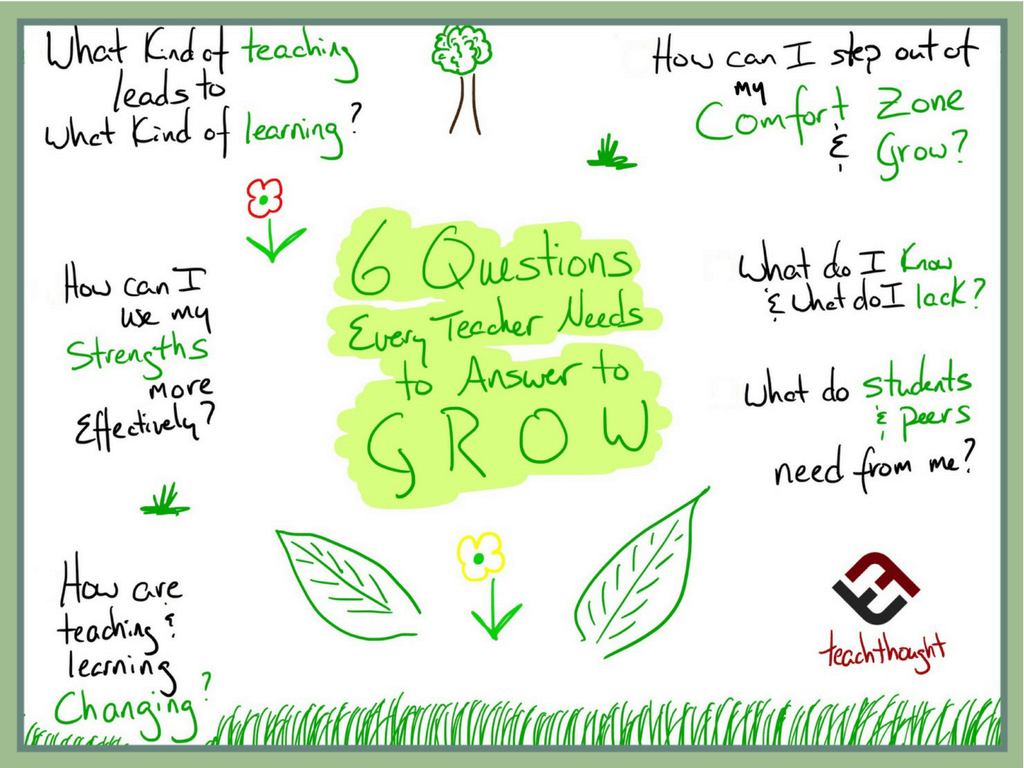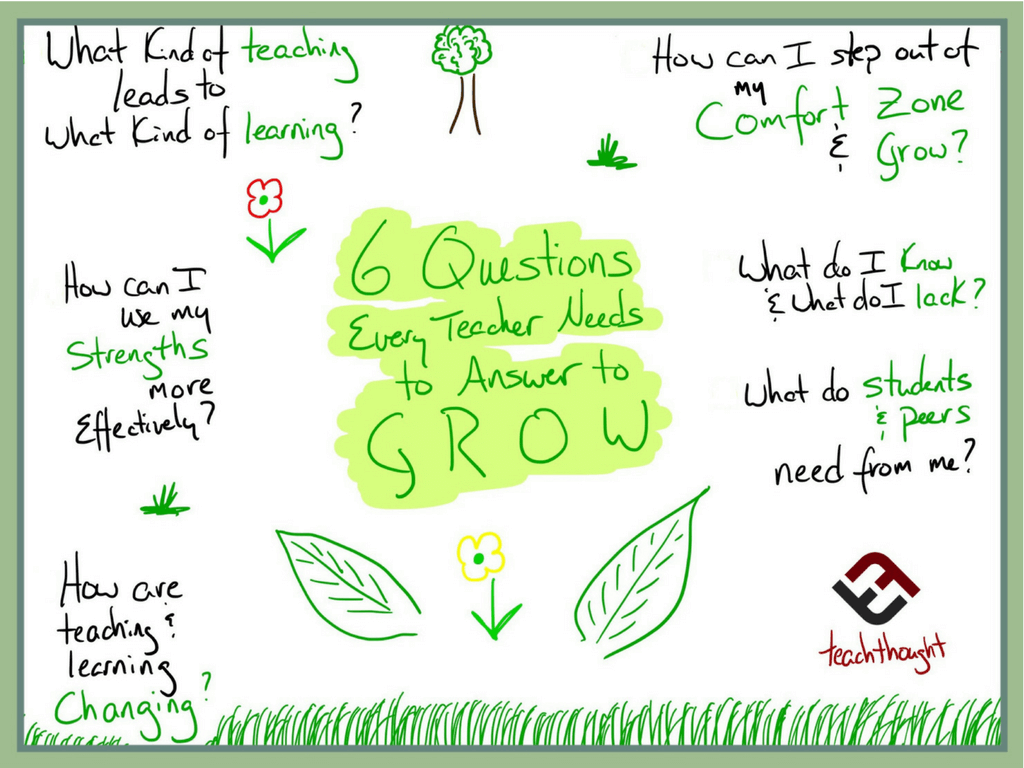
6 Questions Every Teacher Needs To Answer In Order To Grow
by Terry Heick
Broadly speaking, there are two types of professional development (or “PD”): formal and informal.
The latter is a new breed of PD, characterized by teachers interacting, collaborating, and improving via technology. Social media platforms like twitter and Facebook, and also blogs and social bookmarking platforms like pinterest give teachers what-they-want, when-they-want-it access to an incredible diversity of resources. This approach also naturally expands teacher networks for iterative, long-term improvement as teachers continue to model, share, and grow.
Today, there is still room for face-to-face, in-person PD. For years, this model has been the face of teacher improvement–educators attending school and district-sponsored trainings in huge masses to address the latest and greatest push from the top down. Topics ranging from curriculum and assessment to literacy and instruction, classroom management or new technology are covered here, often during summer or holiday break, or PD/conference days in a school media center, computer lab, or cafeteria.
On a larger scale, there is a similar type of teacher PD sponsored by larger teacher improvement organizations. These companies sponsor huge teacher conferences that are hosted in hotels and convention centers, featuring sometimes hundreds of sessions, keynote speakers, and even pre-conference institutions.
Of course, the above is only the beginning. There are also webinars, eLearning courses, and direct consulting to improve an educator’s craft, in addition to books, eBooks, and the local professional learning community.
And the best part? Many of these resources are free and can used based on a teacher’s–ahem–supply of free time.
Primary Catalysts for Teacher Improvement
The primary catalysts for teacher improvement are resources and reflection.
If teachers have access to quality resources that make sense for their classroom, having the time, framework, collaboration, and even data to meaningfully reflect on the performance of those resources is the critical next step.
So when it’s time to pick, what kinds of questions should you consider to get the most out of your investment? The most macro, of course are, ‘Who am I teaching, and what do they need from me?’ But in terms of growing with peers through formal and informal ‘professional development,’ you might consider the following questions.
1. What kind of teaching leads to what kind of learning?
To grow, you need to know what teaching and learning ‘are.’
What does it mean to ‘understand’? What does it mean to ‘teach’? How does the latter affect the former?
What is critical thinking?
What is the difference between differentiation and personalized learning? What indicators can I look for as a teacher that a student ‘get it’–not test ‘data’ but the informal bits that you see every day in the classroom?
How does learning feedback create a feedback loop that supports intellectuals growth, and how does assessment design factor in?
Is a flipped classroom right for me? If so, where should I start?
These sorts of questions drive teacher inquiry, and teacher inquiry drives teacher growth.
2. How can I challenge myself while protecting myself as a teacher?
While it makes perfect sense to prioritize, build on your strengths, and know what’s available for free, you also need to be willing to step out of your comfort zone. Diversity is a key for growth, and knowing yourself as a professional–where you’re overdeveloped and where you might be the opposite–is important.
So ask other teachers. Ping your digital professional learning network on twitter. Read your favorite blog for trends. Stick with what got you there, but don’t be afraid to try new things. Just because you attend training doesn’t mean it all has to end up in your classroom. But it might.
Now doing all of this while protecting your well-being as a teacher and actual living person is the modern challenge.
3. What do I need–exactly–to serve students?
At this point, you’ve narrowed your professional development options from everything in the know PD universe to the ‘How can I move out of my comfort zone to pursue the most important skills?’
Then you can survey the development you’ve had in the past–any development at all, from formal professional development to informal self-directed improvement.
If you’ve attended a pre-conference session on Instructional Strategies in the recent past, while it seems tempting to move in another direction completely, choosing something involving classroom management or iPad integration, it might make sense to instead deepen your existing training–for example, a move to Student-Centered Instructional Strategies or Using Data to Modify Instruction or even using eLearning and remote teaching to supplement your teaching.
Growing as a teacher requires knowing what you know and what you don’t know, and neither are as simple as they seem. As adults, we rarely are aware of what we’re not aware of, which is a dizzying reality that can hamper teacher growth.
What do you need and where can you sustainably and credibly receive it?
4. How can I use my strengths more effectively?
Knowing thyself–and know thy strengths.
Teacher professional growth plans are often built around weaknesses, with evaluations pointing out your shortcomings so you can improve. But there is something to be said for building on your strengths instead–knowing where you’re naturally ‘good’ and staying in that sweet spot as much as possible, not out of timidity, but logic.
One tip to help you find what’s most important is to identify the keystones of teaching–those middle anchors that everything else depends on (usually curriculum or instructional design). Like power standards in Common Core, identifying those “power skills” in education are equally important as they can set the foundation for all of your other training.
If you’re incredible with grouping and differentiation, use that. Find PDs that further those skills so that you can get the most out of them to support areas where you’re not so incredible. Every teacher is good at something. Know what you’re good at, and grow from there.
5. What do my students and colleagues need from me and I from them?
What ‘systems’ am I a part of as a teacher? In my classroom? In my department or on my team? In my school or district? In the lives of my students and their families? In my PLN?
Another important element of choosing a PD is knowing what others are doing and what they need from you.
As a teacher, you’re a single gear in a huge machine that depends on you to be great. That doesn’t mean you leap at the first available training that explores something administrators have been screaming for, but once you’ve narrowed down your choices to this point, it now makes sense to support the educators around you.
Send some emails. Make some phone calls. Find out where the ‘district is going’ next year and beyond, and identify training that overlaps between your needs and theirs.
But more critically, get to know your students. Use project-based learning so that they can reveal who they are and where they come from. Talk to parents. Consider home-visits. Conference with students throughout the year. Use a learning management system with messaging–whatever it takes to have an open line of communication between you and students. In addition to their performance in the classroom, this will lay a strong foundation for getting to know your students.
6. How are teaching and learning changing?
These two questions drive a lot of work at TeachThought, and answering them is a never-ending process because change doesn’t stop.
But if you can’t come up with a decent answer as to how it’s changing and a pretty good guess where it might be ‘going,’ you’ll always be lagging years behind others, picking and choosing between this book and this school-provided PD and this compelling video and so on, trying to figure out who to follow forward. The more you know, the better you’ll be able to separate the wheat from the chaff and choose your own ways to grow moving forward.
You can read more–well, anywhere on TeachThought, but could start with ‘How Teaching Is Changing.’
Conclusion
Getting the most out of professional development is really an exercise in deduction and common sense.
The right idea or support system at the right time can make all the difference in your career. For new teachers, it can be a chance to get the lay of the land, find out what others are doing, and form a strategy for self-improvement that can help you achieve all of your professional goals.
For veteran teachers, there’s always more to learn, and you never know when you’re going to find that new wrinkle, trend, or technology that will transform the learning of your students, or rekindle your enthusiasm for your craft.

